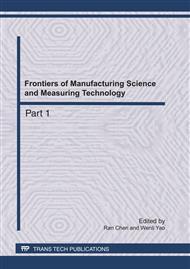p.1010
p.1014
p.1019
p.1024
p.1029
p.1034
p.1039
p.1045
p.1049
A Study on Elliptical Vibration Cutting by Finite Element Analysis
Abstract:
In order to reveal the mechanistic characteristics during the elliptical vibration cutting (EVC), A simplified 2-D finite element model is developed. The characteristics of the cutting forces during the EVC process are investigated by comparison with the conventional cutting. The results indicate that the lower averaging values of cutting forces can be obtained and an obvious inverse phenomenon of the thrust force is also observed during the EVC process, which may be beneficial to the chip formation. A detailed analysis of the equivalent stress distribution during the EVC process is carried out. A transient stress distribution is observed during the EVC process, the highly localized Von Mises stress in the tool-chip contact region throughout one EVC cycle may help to form a more continuous chip and lead to the ductile regime removal of brittle materials.
Info:
Periodical:
Pages:
1029-1033
Citation:
Online since:
May 2011
Authors:
Price:
Сopyright:
© 2011 Trans Tech Publications Ltd. All Rights Reserved
Share:
Citation:


